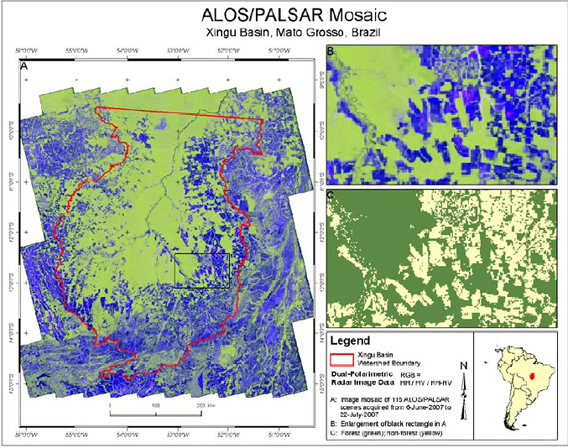New satellite system will penetrate clouds to track deforestation
New satellite system will penetrate clouds to track deforestation
mongabay.com
December 5, 2007
Satellite monitoring will play a critical role in any agreement that compensates tropical countries for preserving their forests, such as “Reduced Emissions from Deforestation and Degradation” (REDD) mechanisms currently under discussion at UN climate talks in Bali. Released Tuesday, a new study, “New Eyes in the Sky: Cloud-Free Tropical Forest Monitoring for REDD with the Japanese Advanced Land Observation Satellite (ALOS)”, details significant advancements in the field of remote sensing of forests.
The Woods Hole Research Center (WHRC), in collaboration with the Japan Aerospace Exploration Agency (JAXA) and the European Commission Joint Research Centre (JRC), report that data from the Japanese Advanced Land Observation Satellite (ALOS) can be used to assemble high-resolution (20 m) mosaics of radar images for very large areas of forests anywhere in the world. The work could help policymakers and scientists track deforestation and monitor resulting greenhouse gas emissions, even when forest areas are obstructed by clouds and smoke.
 Xingu Basin Watershed, Mato Grasso, Brazil. The radar image mosaic, is a composite of 116 individual scenes (400,000 km2) acquired by the PALSAR sensor carried on board ALOS. The image acquisitions were made between June 8 and July 22, 2007. From the mosaic, Dr. Kellndorfer’s group has generated a preliminary land cover classification with emphasis on producing an accurate forest/nonforest map. In the forested areas, the sensitivity of the PALSAR data to differences in aboveground biomass is also being investigated in collaboration with the Amazon Institute of Environmental Research (IPAM). |
“JAXA has launched an amazing sensor which exhibits unprecedented geometric and radiometric accuracies,” said WHRC scientist Josef Kellndorfer. “Thanks to a dedicated observation strategy, this allows us to obtain wall-to-wall, high-resolution, and cloud-free radar observations of tropical forests several times per year for years to come. With similar instruments planned for launch during the next couple of years by space agencies in Japan, Europe, Germany, Italy, and the U.S., this marks a new era in remote sensing of natural resources.”
Josef Kellndorfer (2007). New Eyes in the Sky: Cloud-Free Tropical Forest Monitoring for REDD with the Japanese Advanced Land Observation Satellite (ALOS) [PDF]. The Woods Hole Research Center. United Nations Framework Convention on Climate Change (UNFCCC) Conference of the Parties (COP), Thirteenth session. 3-14 December 2007
Related
Ground-breaking Amazon rainforest imagery will help monitor deforestation
(11/27/2007) Scientists have developed a ground-breaking high resolution snapshot of 400,000 square kilometers of Amazon rainforest. The work will help researchers remotely monitor deforestation, according to the Woods Hole Research Center (WHRC). The researchers say remote sensing systems will play a critical role in the development of REDD (Reduced Emissions from Deforestation and Degradation) mechanisms that seek to compensate tropical forest nations for avoiding and reducing deforestation.